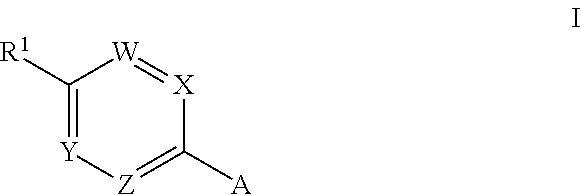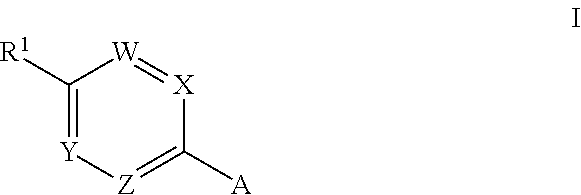Novel Medicaments
a technology of medicaments and compounds, applied in the field of new compounds, can solve the problems that not all the objects mentioned below may be fully overcome or improved
- Summary
- Abstract
- Description
- Claims
- Application Information
AI Technical Summary
Benefits of technology
Problems solved by technology
Method used
Image
Examples
example 1
General Procedure A
1-[5-(4-Chlorophenyl)pyridin-2-yl]-4-isopropylpiperazine, dihydrochloride
[0327]
A mixture of 2-chloro-5-(4-chlorophenyl)pyridine (500 mg, 2.23 mmol), DMSO (2.0 mL) and 1-isopropylpiperazine (3 mL, 23.4 mmol) was stirred and heated on a 100° C. oil-bath overnight. The reaction mixture was poured into water (75 mL), and the solid was isolated by filtration, washed with water and dried. The crude product was purified by column chromatography on silica gel (Kiselgel 60, mesh 0.040-0.63) eluting with a mixture of ethyl acetate and methanol (4:1). Collecting the proper fractions afforded 600 mg (85%) of 1-[5-(4-chlorophenyl)pyridin-2-yl]-4-isopropylpiperazine.
[0328]1H NMR (300 MHz, CDCl3) δ 1.10 (d, 6H), 2.63-2.68 (m, 4H), 2.75 (hept, 1H), 3.59-3.66 (m, 4H), 6.69 (d, 1H), 7.35-7.45 (m, 4H), 7.67 (dd, 1H), 8.40 (d, 1H).
The free base was dissolved into a mixture of a 0.5 N hydrochloric acid solution and ethanol. When dissolved, the mixture was evaporated and then re-evapor...
example 2
General Procedure A
1-Isopropyl-4-[5-(4-methoxyphenyl)pyridin-2-yl]piperazine, dihydrochloride
[0333]
A mixture of 2-chloro-5-(4-methoxyphenyl)pyridine (200 mg, 0.91 mmol), dry DMSO (2.0 mL) and 1-isopropylpiperazine (500 mg, 3.9 mmol) was stirred and heated on a 130° C. oil-bath overnight, then at 150° C. for 4 h, left 2 days at rt and finally heated at 140° C. overnight. The reaction mixture was allowed to cool and then poured into water (100 mL). The mixture was extracted with ethyl acetate (100 mL), and the organic extract was washed with water and dried (MgSO4). The solvent was evaporated to give a solid residue which was dissolved into 0.5 N hydrochloric acid (20 mL). A small insoluble solid was removed by filtration, and the aqueous solution was evaporated to give a residue which was re-evaporated with absolute ethanol. The resulting solid was re-crystallised from absolute ethanol to give 210 mg (60%) of 1-[5-(4-methoxyphenyl)pyridin-2-yl]-4-isopropylpiperazine, dihydrochloride....
example 3
General Procedure A
1-Isopropyl-4-[5-(4-trifluoromethoxyphenyl)pyridin-2-yl]piperazine, dihydrochloride
[0338]
The title compound was prepared by a similar procedure to that described in Example 1, starting from 2-chloro-5-(4-trifluoromethoxyphenyl)pyridine and 1-isopropylpiperazine.
[0339]Mp=271-273° C.
[0340]1H NMR (300 MHz, DMSO-d6) δ 1.32 (d, 6H), 3.05-3.21 (m, 2H), 3.45-3.67 (m, 5H), 4.50-4.61 (m, 2H), 7.28 (d, 1H), 7.46 (d, 2H), 7.82 (d, 2H), 8.17 (d, 1H), 8.46 (s, 1H), 11.4 (brs, 1H).
[0341]Microanalysis for C19H22F3N3O, 2×HCl:
[0342]Calculated: C, 52.06%; H, 5.52%; N, 9.59%.
[0343]Found: C, 52.07%; H, 5.53%; N, 9.36%.
PUM
 Login to View More
Login to View More Abstract
Description
Claims
Application Information
 Login to View More
Login to View More - R&D
- Intellectual Property
- Life Sciences
- Materials
- Tech Scout
- Unparalleled Data Quality
- Higher Quality Content
- 60% Fewer Hallucinations
Browse by: Latest US Patents, China's latest patents, Technical Efficacy Thesaurus, Application Domain, Technology Topic, Popular Technical Reports.
© 2025 PatSnap. All rights reserved.Legal|Privacy policy|Modern Slavery Act Transparency Statement|Sitemap|About US| Contact US: help@patsnap.com



